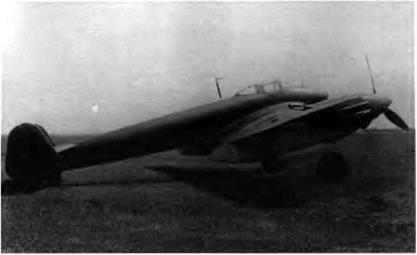PBSh-2
A note came with the PBSh-2 preliminary design created by the factory no. 1 OKO in July 1940. It said: "Considering that hedge-hopping flying in a highly wing-loaded aircraft is rather demanding and moreover that monoplanes seldom forgive pilots’ mistakes at very low altitudes, we have chosen the biplane configuration for the PBSh-2, even though it has been designed to carry out the same missions as the PBSh-1. Biplanes are much easier to fly. They have far better stability and maneuverability."
The PBSh-2 silhouette was quite unusual. Areas of the two wings of this biplane were quite different. The smaller upper wing had a forward sweep angle of 12 degrees and no ailerons. A light dihedral was applied to the lower wing outer panels. The whole trailing edge was
|
|
The unorthodox PBSh-2 was no more successful than the PBSh-1. The VVS chose instead the Ilyushin shturmovik, the 11-2.
occupied by large ailerons and two-segment flaps. The wings were braced by I-type struts.
Like the PBSh-1, the engine was to be a 1,178 kW (1,600 ch) AM-38 protected (along with the fuel tanks and cockpit) by case-hardening homogenized armor plates whose thickness varied from 7.5 to 15.5 mm. The planned armament was similar to that of the PBSh-1: two 23- mm cannons and six 7.62-mm machine guns.
The center section of the lower wing contained two bays for 1- to 10-kg (2.2- to 22-pound) bombs. As with the PBSh-1, the 25- to 250-kg (65- to 550-pound) bombs were strapped beneath the wings for dive – bombing missions, whatever the diving angle might be. But because 11- 2 production was stepped up at several factories, all work on the PBSh – 2 stopped by the end of 1940.
In some OKB documents the PBSh-2 is referred to as the MiG-6.
Specifications
Span, 8.6/12.4 m (28 ft 2.6 in/40 ft 8.2 in); length, 8.85 m (29 ft 0.4 in); height, 3.5 m (11 ft 5.8 in); wheel track, 2.97 m (9 ft 8.9 in); wheel base, 5.23 m (17 ft 1.9 in); wing area, 10.26/22.14 m2 (110.44/238.3 sq ft); takeoff weight, 4,828 kg (10,641 lb); wing loading, 149 kg/m2 (30.5 lb/sq ft).
Design Performance
Max speed at sea level, 426 km/h (230 kt); range, 740 km (460 mi); range with two 100-1 (26.4-US gal) auxiliary tanks, 929 km (577 mi).
|
The DIS-200 (T) is sometimes referred to as the DIS 2AM-37 because of its power plant. The engine exhaust pipes extend above the wing’s upper surface. |












